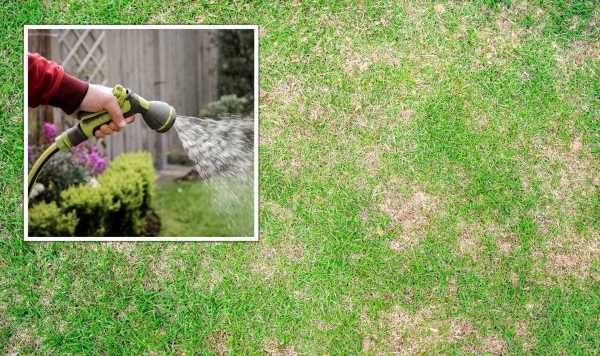Garden tips: How to maintain your lawn
We use your sign-up to provide content in ways you’ve consented to and to improve our understanding of you. This may include adverts from us and 3rd parties based on our understanding. You can unsubscribe at any time. More info
The only time gardeners should be watering their lawn is when it tells you to, not according to some arbitrary plan. The soil type, grass type, exposure to sun and wind are just a few of the factors that will determine how frequently it needs water. Usually the rain is more than enough water that gardeners need not bother with the task of watering.
Veteran British horticulturist, Stefan Buczacki, author of more than 50 gardening and natural history books, claimed that watering the lawn is not worth doing.
He said: “Never, ever, water your lawn – it’s a complete waste of time, energy and money.”
Those obsessed with cultivating a pristine lawn, this might be difficult to stick to.
Carlos Real, lawn care expert and managing director of Total Lawn advised: “Do water only if it is unseasonably hot.

“Watering too early in the year encourages shallow root growth, and your grass would not be able to withstand the dry, hot summer weather we’d hope to expect a little later in the year, resulting in patchy, brown grass.”
One of the signs to look for when the lawn is starting to gasp a little is a change in colour with the lawn becoming dull as moisture levels become low.
In addition the lawn will lose its ‘springiness’ and foot prints will remain in the lawn when normally the grass would spring back to shape.
If the lawn has started to turn brown however, gardeners are well passed the watering point and it may be best to let the lawn go dormant.
DON’T MISS:
Cleaning: How to get rid of slugs in homes using salt – ‘cheapest way’ [COMMENT]
Plants to avoid when adding a ‘burst of colour’ to gardens [TIPS]
Oven cleaning: ‘The right technique’ to clean oven door glass properly [EXPERT]
Cutting back on watering as well as the time spent looking after lawns are a garden trend that has been steadily growing in popularity.
This is particularly the case at this time of year thanks to the Plantlife charity’s ‘No Mow May’ campaign.
This encourages homeowners to leave their best lawnmower in the shed for a little longer and let wildflowers bloom to provide a nectar feast for pollinators such as honeybees, bumblebees and solitary bees, butterflies and moths, and beetles.
Felicity Harris, head of participation at Plantlife explained: “Each year the trend towards wilder lawns is growing from the grassroots up, and it is set to bloom as never before in 2022.

“It is not only plants and pollinators that benefit – we do too.
“Less mowing gives garden lovers more time to relax and reconnect with nature.”
This campaign not only sounds idyllic, but can help the health and appearance of our lawns in the long run.
However, Carlos warned that uncut lawn will pose more harm than good for wildlife.

He said: “Leaving the grass uncut will be more damaging for wildlife long-term.
“It will invite all kinds of wildlife to the lawn to create a home, only then to destroy it and kill the insects in the process when the lawn is mowed again in June.
“For those wanting to create a space for wildlife, a much better idea would be allocating an area of the garden to be a wild area all year round.
“Sowing wildflower seeds will create a great habitat for all kinds of insects and bees.”
Source: Read Full Article
